

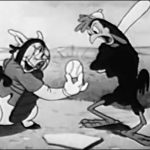

Today’s starting lineup puts heavy emphasis upon the teams from Paul Terry and Warner Brothers, who contribute most of the star players for the early innings. Warner in particular begins to redeem itself for poor batting averages in its first two baseball outings, finding ways to integrate baseball gags as incidental surprise material in stories of other than sports nature. In the late innings, we get a few key pinch hitters subbing in from other teams – out of the Charles Mintz and Max Fleischer triple-A squads.
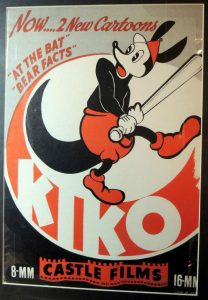 Play Ball (Terrytoons/Educational, Kiko the Kangaroo, 6/11/37 – Mannie Davis, dir.) – An awful lot of cartoons using this same title, aren’t there? Perhaps that’s why Castle Films retitled it for home movie sales. Today’s big game draws the usual crowd, and the usual freeloaders. A dachshund serves as a ramp to allow several small animals to climb through a fence knothole to interior seating. The dachshund climbs through after them, leaving one of the small creatures behind. The little guy leaps and leaps, finally getting hold of the knothole with one hand, and pulling it down to his own height to climb in. A portly pig spots the entrance, and himself shoves his way into the hole, widening the wood opening about three extra sizes in diameter in the process. He then ensures that no further intruders will follow, by zipping the hole closed with a zipper.
Play Ball (Terrytoons/Educational, Kiko the Kangaroo, 6/11/37 – Mannie Davis, dir.) – An awful lot of cartoons using this same title, aren’t there? Perhaps that’s why Castle Films retitled it for home movie sales. Today’s big game draws the usual crowd, and the usual freeloaders. A dachshund serves as a ramp to allow several small animals to climb through a fence knothole to interior seating. The dachshund climbs through after them, leaving one of the small creatures behind. The little guy leaps and leaps, finally getting hold of the knothole with one hand, and pulling it down to his own height to climb in. A portly pig spots the entrance, and himself shoves his way into the hole, widening the wood opening about three extra sizes in diameter in the process. He then ensures that no further intruders will follow, by zipping the hole closed with a zipper.
Kiko’s Australian Champs take the field – Kiko himself, and a team of look-alike junior Joeys, all dressed in baseball uniforms. The Jungle Giants, apparently switching from softball to baseball mode, commute from Oswald’s stadium last week to make an appearance here. Farmer Al Falfa cameos as umpire. Quite a bit of retreaded action ensues which we’ve seen before, along with a few new gags. Kiko doffs his hat to the crowd, removing his ears with it at the same time. He pitches with his tail to an ostrich. Two balls, and a curve that circles the batter 360 degrees, and the ostrich is out. Next, a gorilla. This seems to be the same chap from “The Magnetic Bat”, engaging in the same base-running scheme of reaching with his arms from one base to the next before advancing. One run scored. In the stands, a small monkey can’t see past the neck of a giraffe seated ahead of him, so yanks on the giraffe’s tail, causing his neck to retract into his collar. A knot tied in the tail keeps the neck down, so the monk can enjoy the game. A pig with something of the build of the Babe steps up. Instead of selecting a bat, he chooses a golf club from a bag of clubs held by a caddy. He smacks the ball as if teeing off from the plate, and the ball joes down the open mouth of a man illustrated on an outfield fence advertisement for a cold cure. The pig circles the bases with his caddy, and scores run number two.
 Up comes an elephant, with a pivoting swing so strong, he spins like a top, and kicks up a wind that almost blows the fans out of the grandstand. On Kiko’s second pitch, the elephant catches the ball with his trunk, tosses it up in front of him, and smacks it for a record-setting blow. The ball sails out of the park, spinning almost with the speed of a buzz-saw. It intercepts a bird on the fly, and the friction of its spinning plucks the bird clean of feathers. In a shot from outer space, the ball performs an orbit around the globe. But this proves to be the elephant’s undoing, as the ball falls out of orbit, right over home plate, into the catcher’s mitt. The catcher braces himself for the tag, as the mighty elephant slides, straight into both the catcher and Farmer Al, taking them all right through the backstop fence. Farmer Al re-emerges from the hole, and calls the play: “Yer Out!”
Up comes an elephant, with a pivoting swing so strong, he spins like a top, and kicks up a wind that almost blows the fans out of the grandstand. On Kiko’s second pitch, the elephant catches the ball with his trunk, tosses it up in front of him, and smacks it for a record-setting blow. The ball sails out of the park, spinning almost with the speed of a buzz-saw. It intercepts a bird on the fly, and the friction of its spinning plucks the bird clean of feathers. In a shot from outer space, the ball performs an orbit around the globe. But this proves to be the elephant’s undoing, as the ball falls out of orbit, right over home plate, into the catcher’s mitt. The catcher braces himself for the tag, as the mighty elephant slides, straight into both the catcher and Farmer Al, taking them all right through the backstop fence. Farmer Al re-emerges from the hole, and calls the play: “Yer Out!”
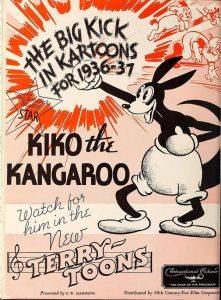 I only counted two out, but the sides change. The gorilla pitches to one of Kiko’s Joeys. The first pitch hits Farmer Al, knocking off the bird cage he has been wearing in place of an umpire mask, which lands on the little kangaroo’s head, causing him briefly to see his own tweeting birds within the cage. The next gag we’ve seen before from Van Beuren’s “Play Ball”, obviously remembered by Davis who co-directed the former film, with the gorilla applying chewing gum between the ball and his throwing hand, causing the ball to stop just shy of the plate, get the batter to swing, then return to him. But we get a new twist on the idea, as the gorilla detaches the gum from his hand, then turns the ball around, throwing it gum-side first at the batter. The frustrated Roo finds himself playing the equivalent of kiddie paddleball, with the ball tethered to the bat by the gum, incapable of being swatted away. The Roo finally gets his swing right, snapping the gum, and hitting the laughing gorilla in the head. The runner falls into the familiar position of being caught between second and third, and Davis again return to Van Beuren’s “Play Ball”, with the Roo diving underground to continue running. A slight variation is added, as an ostrich baseman buries his head in the dirt to follow the Roo in his underground trek, clear around the bags to home plate. The ostrich overshoots his mark, his head coming out of the dirt past the plate, while the Roo pops out directly underneath home, and is caled “Safe” by Farmer Al. Now Kiko steps to bat. He clouts a good one, and begins running. He turns out to be carrying the whole team with him in his pouch, who hop out of Kiko’s and each other’s pouches one-by-one until they are all circling the bags. Again lifting for the third time from Van Beuren’s “Play Ball”, the ostrich yells “I got it”, but swallows the ball. The fielders again are left unable to get the ball out of the ostrich’s throat, as the kangaroos keep circling the bases, for the iris out.
I only counted two out, but the sides change. The gorilla pitches to one of Kiko’s Joeys. The first pitch hits Farmer Al, knocking off the bird cage he has been wearing in place of an umpire mask, which lands on the little kangaroo’s head, causing him briefly to see his own tweeting birds within the cage. The next gag we’ve seen before from Van Beuren’s “Play Ball”, obviously remembered by Davis who co-directed the former film, with the gorilla applying chewing gum between the ball and his throwing hand, causing the ball to stop just shy of the plate, get the batter to swing, then return to him. But we get a new twist on the idea, as the gorilla detaches the gum from his hand, then turns the ball around, throwing it gum-side first at the batter. The frustrated Roo finds himself playing the equivalent of kiddie paddleball, with the ball tethered to the bat by the gum, incapable of being swatted away. The Roo finally gets his swing right, snapping the gum, and hitting the laughing gorilla in the head. The runner falls into the familiar position of being caught between second and third, and Davis again return to Van Beuren’s “Play Ball”, with the Roo diving underground to continue running. A slight variation is added, as an ostrich baseman buries his head in the dirt to follow the Roo in his underground trek, clear around the bags to home plate. The ostrich overshoots his mark, his head coming out of the dirt past the plate, while the Roo pops out directly underneath home, and is caled “Safe” by Farmer Al. Now Kiko steps to bat. He clouts a good one, and begins running. He turns out to be carrying the whole team with him in his pouch, who hop out of Kiko’s and each other’s pouches one-by-one until they are all circling the bags. Again lifting for the third time from Van Beuren’s “Play Ball”, the ostrich yells “I got it”, but swallows the ball. The fielders again are left unable to get the ball out of the ostrich’s throat, as the kangaroos keep circling the bases, for the iris out.
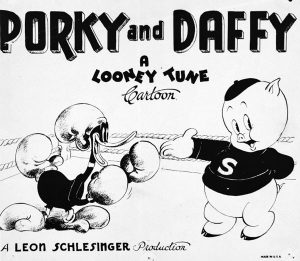 Porky and Daffy (Warner, Looney Tunes, 8/6/38, Robert Clampett, dir.) The earliest re-pairing of the pig and duck since their first encounter in “Porky’s Duck Hunt”. Technically, this film shouldn’t have anything to do with baseball, as the action is centered around Daffy’s entry into the prize-fight game, with Porky as manager. He battles a champion rooster who challenges all comers. Daffy well-earns his name with his wild antics in this one, including evading the champ’s blows by hopping upon an imaginary invisible bicycle and riding around the ring. “I’m so crazy, I don’t know this is impossible”, utters Daffy to the audience. The champ finally gets Daffy where he wants him, holding out a peppermint stick to lure the sweet-toothed duck to him, then pulling down a curtain over the action, reading “Censored”, as the sounds and curtain bulges we see tell us that Daffy is clearly taking a beating. Daffy receives a “long count” from the pelican referee (“One, Two…button my shoe…”), while Porky races homm to retrieve something he has used to awaken Daffy from morning slumber – the metal cover of a banquet dinner plate – which he rings like a gong over Daffy’s head to revive him. Daffy hides behind one of the four posts of the ring, while the champ tries to telegraph long punches at him which stretch his arm nearly clear across the ring. Daffy then pulls a fast and clever finale trick – by standing atop the ring post, holding a baseball bat. Daffy slugs a powerful swing at the champ’s oncoming fist, knocking it for a hit that sends the champ’s extended arm wrapping around his own body in a spiral, with his fist finally landing a direct blow upon his own jaw, knocking him to the floor. With a flurry of “Woo Woo”’s, Daffy runs from ring post to ring post as if he were rounding the bases of a baseball diamond, then slides back to the pole from which he started. The pelican referee suddenly appears, wearing an umpire’s mask and gear, and calls out “Safe!” He then turns to the fallen champ, this time counting out numbers up to 10 in double tempo, and declares, “You’re out!” For a final blow, Daffy appears within the beak pouch of the pelican, carrying the dinner plate lid seen earlier, and bongs the lid over the champ’s head, reviving him in the same way Porky did. The effect of the reverberations must be contageous, and the possible source of Daffy’s looniness, as the champ reacts just as Daffy did, in a fit of wild “Woo Woo”’s, for the iris out.
Porky and Daffy (Warner, Looney Tunes, 8/6/38, Robert Clampett, dir.) The earliest re-pairing of the pig and duck since their first encounter in “Porky’s Duck Hunt”. Technically, this film shouldn’t have anything to do with baseball, as the action is centered around Daffy’s entry into the prize-fight game, with Porky as manager. He battles a champion rooster who challenges all comers. Daffy well-earns his name with his wild antics in this one, including evading the champ’s blows by hopping upon an imaginary invisible bicycle and riding around the ring. “I’m so crazy, I don’t know this is impossible”, utters Daffy to the audience. The champ finally gets Daffy where he wants him, holding out a peppermint stick to lure the sweet-toothed duck to him, then pulling down a curtain over the action, reading “Censored”, as the sounds and curtain bulges we see tell us that Daffy is clearly taking a beating. Daffy receives a “long count” from the pelican referee (“One, Two…button my shoe…”), while Porky races homm to retrieve something he has used to awaken Daffy from morning slumber – the metal cover of a banquet dinner plate – which he rings like a gong over Daffy’s head to revive him. Daffy hides behind one of the four posts of the ring, while the champ tries to telegraph long punches at him which stretch his arm nearly clear across the ring. Daffy then pulls a fast and clever finale trick – by standing atop the ring post, holding a baseball bat. Daffy slugs a powerful swing at the champ’s oncoming fist, knocking it for a hit that sends the champ’s extended arm wrapping around his own body in a spiral, with his fist finally landing a direct blow upon his own jaw, knocking him to the floor. With a flurry of “Woo Woo”’s, Daffy runs from ring post to ring post as if he were rounding the bases of a baseball diamond, then slides back to the pole from which he started. The pelican referee suddenly appears, wearing an umpire’s mask and gear, and calls out “Safe!” He then turns to the fallen champ, this time counting out numbers up to 10 in double tempo, and declares, “You’re out!” For a final blow, Daffy appears within the beak pouch of the pelican, carrying the dinner plate lid seen earlier, and bongs the lid over the champ’s head, reviving him in the same way Porky did. The effect of the reverberations must be contageous, and the possible source of Daffy’s looniness, as the champ reacts just as Daffy did, in a fit of wild “Woo Woo”’s, for the iris out.
• PORKY AND DAFFY can be viewed on DailyMotion.
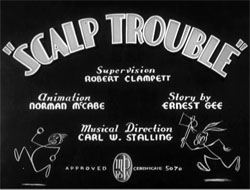 Scalp Trouble (Warner, Looney Tunes (Porky Pig and Daffy Duck), 7/24/39 – Robert Clampett, dir.) – Daffy’s back. as a Napoleon-like general of a cavalry fort in the old West. He prompts the blowing of reveille by pulling an inches-long sword from a feet-long scabbard, and sticking the point into the rear-end of the sleeping bugler. He shouts orders into the barracks for the troops to get up, with the snide remark, “Whadd’ya think this is, a rest home?” Everyone stampedes out the door, trampling him, except Porky, who still snoozes away. Daffy practically throws a tantrum over Porky’s upper bunk, but nothing will rouse the snoring pig. Exhausted, Daffy joins him in bed, but the extra weight causes the bunk to collapse, finalluy rousing obedient Porky into “shoulder arms” formation.
Scalp Trouble (Warner, Looney Tunes (Porky Pig and Daffy Duck), 7/24/39 – Robert Clampett, dir.) – Daffy’s back. as a Napoleon-like general of a cavalry fort in the old West. He prompts the blowing of reveille by pulling an inches-long sword from a feet-long scabbard, and sticking the point into the rear-end of the sleeping bugler. He shouts orders into the barracks for the troops to get up, with the snide remark, “Whadd’ya think this is, a rest home?” Everyone stampedes out the door, trampling him, except Porky, who still snoozes away. Daffy practically throws a tantrum over Porky’s upper bunk, but nothing will rouse the snoring pig. Exhausted, Daffy joins him in bed, but the extra weight causes the bunk to collapse, finalluy rousing obedient Porky into “shoulder arms” formation.
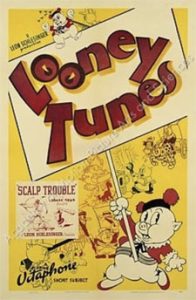 An elaborate Indian attack is waged against the fort. All manner of “redskin” gags appear, including one brave who gains entrance to the fort by spitting “fire-water” upon the fort fence, burning a hole in just his shape. Perhaps the most well-remembered gag, reused in various subsequent cartoons such as “Tom Tom Tomcat” and “Horse Hare”, is a cavalry man taking pot shots with his firearm from the fort parapets, and keeping score with hash marks on the fence in chalk, to the tune “One little, two little, three little Indians.” After racking up his ninth hit, the cavalry man is surprised by an Indian appearing over the fence, armed with tomahawk. “Ten little Indian boys!”, the brave shouts, in a voice that sounds more like Rochester from Jack Benny. He conks the soldier on the head, laying him flat on the ground. The soldier briefly revives, long enough to erase one hash mark on the fence to correct the score. Porky is ambushed by another Indian who has sneaked into the fort, just as Porky’s guns run out of ammo. In a Jerry Colonna-style read, the Indian addresses Porky: “Greetings, Gate! Let’s scalp-itate!” Backing away nervously, Porky calls for anyone to provide “More ammunition!” Daffy reappears (having been hiding under his General’s hat). He races for the ammo dump door, then reappears through the wall, carrying a pile of various ammunition three times taller than he is. In his haste, he stumbles, and the ammo flies everywhere. A powder horn lands in Daffy’s bill, followed by a trail of black powder and shot into the funnel end of the horn, force-feeding Daffy with explosives. The bloated duck attempts to stand, and cautiously proceeds forward, but falls again. The impact ignites the contents within him, and bullets begin escaping his mouth like a human machine gun, together with periodic blasts that resemble a cannon. Observant Porky spots the display, and races to grab Daffy up under his arm, aiming him like a rifle, to pepper the helpless Indians with shot and shell. The entire tribe races for a cliff face, and burrows escape tunnels in its side, each hole taking the shape of a letter or number, which together provide the baseball-reference payoff, reading “Yanks beat Indians, 11-3!”.
An elaborate Indian attack is waged against the fort. All manner of “redskin” gags appear, including one brave who gains entrance to the fort by spitting “fire-water” upon the fort fence, burning a hole in just his shape. Perhaps the most well-remembered gag, reused in various subsequent cartoons such as “Tom Tom Tomcat” and “Horse Hare”, is a cavalry man taking pot shots with his firearm from the fort parapets, and keeping score with hash marks on the fence in chalk, to the tune “One little, two little, three little Indians.” After racking up his ninth hit, the cavalry man is surprised by an Indian appearing over the fence, armed with tomahawk. “Ten little Indian boys!”, the brave shouts, in a voice that sounds more like Rochester from Jack Benny. He conks the soldier on the head, laying him flat on the ground. The soldier briefly revives, long enough to erase one hash mark on the fence to correct the score. Porky is ambushed by another Indian who has sneaked into the fort, just as Porky’s guns run out of ammo. In a Jerry Colonna-style read, the Indian addresses Porky: “Greetings, Gate! Let’s scalp-itate!” Backing away nervously, Porky calls for anyone to provide “More ammunition!” Daffy reappears (having been hiding under his General’s hat). He races for the ammo dump door, then reappears through the wall, carrying a pile of various ammunition three times taller than he is. In his haste, he stumbles, and the ammo flies everywhere. A powder horn lands in Daffy’s bill, followed by a trail of black powder and shot into the funnel end of the horn, force-feeding Daffy with explosives. The bloated duck attempts to stand, and cautiously proceeds forward, but falls again. The impact ignites the contents within him, and bullets begin escaping his mouth like a human machine gun, together with periodic blasts that resemble a cannon. Observant Porky spots the display, and races to grab Daffy up under his arm, aiming him like a rifle, to pepper the helpless Indians with shot and shell. The entire tribe races for a cliff face, and burrows escape tunnels in its side, each hole taking the shape of a letter or number, which together provide the baseball-reference payoff, reading “Yanks beat Indians, 11-3!”.
Remade in Technicolor in the 1940’s as “Slightly Daffy”, with much retraced animation, but several major and minor revisions (no establishing shot of the fort, less Indians in an early shot peering over the fort fence, Porky snoring in the rhythm of “Casablanca”’s hit tune, “As Time Goes By”, substitution of several Indian gags from other films such as “Sweet Sioux”, “The Hardship of Miles Standish”, and “Porky’s Phoney Express”, no payoff chalk erasure on the “Ten Little Indians” sequence, a background error where no rock is drawn to explain Daffy’s stumble with the ammunition, and omission of animation of the tribe briefly peeking out from the holes they burrowed into the cliff face to etch the final baseball score). I once edited between a print of the B&W original and the color remake, to create an extended-length version combining the films’ differences that ran close to nine minutes, as the “full epic”.
• SCALP TROUBLE can be seen in its entirety on DailyMotion.
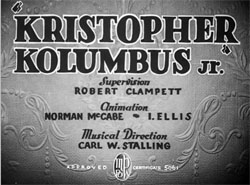 Kristopher Kolumbus, Jr. (Warner, Looney Tunes (Porky Pig), 5/13/39 – Robert Clampett, dir.) – Another film with a clever tangental baseball reference. As the famous explorer, out to prove his theory that the world is round, Porky stages a demonstration before Queen Isabella, pulling from his pocket a baseball. (Never mind that the sport hadn’t been invented yet.) Porky winds up, and throws a colossal pitch, that sails over the Eastern horizon and out of sight. The camera pans back past Porky, and over to the Western horizon, to see the ball sail back into view from the distance, and land for a perfect barehanded catch by Porky. Porky proudly displays the ball, now covered with travel stickers of the type one might find on an old steamer trunk, including stickers from China, Catalina, the New York World’s Fair, and Hollywood Hotel. This gag would be remembered and repeated by Robert McKimson for Bugs Bunny about a decade later, in the subsequent Columbus epic, Hare We Go.
Kristopher Kolumbus, Jr. (Warner, Looney Tunes (Porky Pig), 5/13/39 – Robert Clampett, dir.) – Another film with a clever tangental baseball reference. As the famous explorer, out to prove his theory that the world is round, Porky stages a demonstration before Queen Isabella, pulling from his pocket a baseball. (Never mind that the sport hadn’t been invented yet.) Porky winds up, and throws a colossal pitch, that sails over the Eastern horizon and out of sight. The camera pans back past Porky, and over to the Western horizon, to see the ball sail back into view from the distance, and land for a perfect barehanded catch by Porky. Porky proudly displays the ball, now covered with travel stickers of the type one might find on an old steamer trunk, including stickers from China, Catalina, the New York World’s Fair, and Hollywood Hotel. This gag would be remembered and repeated by Robert McKimson for Bugs Bunny about a decade later, in the subsequent Columbus epic, Hare We Go.
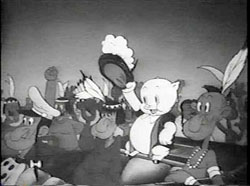 The remainder of the film is a collection of spot gags on ocean voyaging and the discovery of the New World (already ready to welcome the white man tourist). Notably, this probably marks Bob Clampett’s first use of a sea serpent – actually, a pair of them – long before he would become so closely associated with the creatures from “Time For Beany”. Porky brings several members of the Indian tribe back to Spain, to display their never-before-seen ceremonial dancing before the Queen. They break out in a jiving jitterbug production number, set to the recent Warner hit tune, “Jeepers Creepers”. Raising a monocle in disdainful fashion at this sight, the Queen shouts “Stop!”, causing all the dancers to freeze in place. She crosses the hall at a slow, measured pace toward Porky, who cowers in fear that he has displeased the Queen by this disgraceful exhibition. Instead, when the Queen reaches him, she commands “Go!”, and joins Porky in dancing more wild and abandoned than all the others.
The remainder of the film is a collection of spot gags on ocean voyaging and the discovery of the New World (already ready to welcome the white man tourist). Notably, this probably marks Bob Clampett’s first use of a sea serpent – actually, a pair of them – long before he would become so closely associated with the creatures from “Time For Beany”. Porky brings several members of the Indian tribe back to Spain, to display their never-before-seen ceremonial dancing before the Queen. They break out in a jiving jitterbug production number, set to the recent Warner hit tune, “Jeepers Creepers”. Raising a monocle in disdainful fashion at this sight, the Queen shouts “Stop!”, causing all the dancers to freeze in place. She crosses the hall at a slow, measured pace toward Porky, who cowers in fear that he has displeased the Queen by this disgraceful exhibition. Instead, when the Queen reaches him, she commands “Go!”, and joins Porky in dancing more wild and abandoned than all the others.
• KRISTOPHER KOLUMBUS JR. can be seen on DailyMotion.
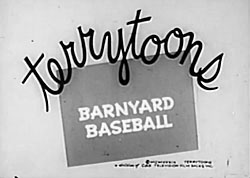 Barnyard Baseball (Terrytoons/Fox, Gandy Goose, 7/14/39 – Mannie Davis, dir.) – We begin with a closeup on a not-too-bright looking canine, who is umpire for the day. He calls for “Play Ball”, but with a stubborn stutter on the B. Gandy Goose is the star pitcher for the home team, which seems to consist of mostly chickens, but with the usual turtle catcher (without his shell turned as a chest protector). The opposing team appears to be a squad of pigs. Gandy’s first pitch is straight over the plate into the catcher’s mitt, but the ump calls “B-b-b-ball.” “What?” shouts Gandy, somewhat miffed. The umpire crosses his eyes, and Gandy begins to understand what kind of a day this might be. He throws again. The ball is smacked right back at him, bending his nose into a droop. He turns to the umpire, asking “Well?”, awaiting the call. The umpire reacts with a start at Gandy’s nose, and calls, “He’s out.” “That’s better”, responds Gandy.
Barnyard Baseball (Terrytoons/Fox, Gandy Goose, 7/14/39 – Mannie Davis, dir.) – We begin with a closeup on a not-too-bright looking canine, who is umpire for the day. He calls for “Play Ball”, but with a stubborn stutter on the B. Gandy Goose is the star pitcher for the home team, which seems to consist of mostly chickens, but with the usual turtle catcher (without his shell turned as a chest protector). The opposing team appears to be a squad of pigs. Gandy’s first pitch is straight over the plate into the catcher’s mitt, but the ump calls “B-b-b-ball.” “What?” shouts Gandy, somewhat miffed. The umpire crosses his eyes, and Gandy begins to understand what kind of a day this might be. He throws again. The ball is smacked right back at him, bending his nose into a droop. He turns to the umpire, asking “Well?”, awaiting the call. The umpire reacts with a start at Gandy’s nose, and calls, “He’s out.” “That’s better”, responds Gandy.
The next batter gets a hit, boring a hole right through Gandy’s mitt, and catching hand as well. While a competent umpire would instantly call the play as interference, the runner is accosted by three chickens, who attempt to keep the pig from advancing from first to second, one hanging on to the pig’s curly tail, while two others stand in front of him, attempting to push him back the other way. The pig mows the two chickens ahead of him down, and slides into second with enough force to smack all the baseman’s feathers off. A third batter steps up. Gandy’s pitch is popped foul behind the plate. The turtle steps back, back, but instead of catching the pop-up, has it land upon his head, forcing him back inside his shell. The turtle shell flips several times over backwards to the backstop. The turtle is forced to emerge from his shell in his underwear, and turn the shell upside down to shake out the ball from his collar. The turtle returns to behind the plate, and the batter makes a solid contact for an infield fly. The batter tosses away the bat and begins to run. Both ball and bat fly high into the air close by one another. Gandy thinks he’s got it, but catches the bat instead, the ball bouncing off his head onto the field. Still, a chicken behind Gandy is able to pick it up and fling it to first in time for an out. But the play works as a sacrifice, and the runner advances to third. Now Gandy is in a predicament, with the runner getting frisky on the bags as if wanting to steal home. Gandy throws another pitch which is hit as a comebacker – but this time, the ball connects with his long neck instead of his nose. His neck responds like an elastic band, and acts as a slingshot to send the ball sailing back to home, in time for an out at the plate. Two gone, with a man on first.
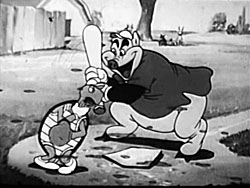 The pigs’ power hitter steps up – a huge, confident fellow. We repeat Terry’s old gag from “The Magnetic Bat”, as a fielder pushes a section of the outfield fence back about 20 feet to extend the field. Gandy first tries a wild spiral warmup to his throw, which also sends the batter into a spiral like a top when the ball hits his bat. Gandy’s second pitch is not so lucky, and the batter clobbers it, again to the mound. “I got it”, shouts Gandy – long enough for the ball to go down his throat, lodging halfway down his neck. A variation on Davis’s “Play Ball” finale and the old mosquito gag from “The Ball Game” takes place, as the fielders, unable to dislodge the ball from Gandy, toss Gandy in to the catcher A continuity error or oversight occurs, as we never see what happened to the pig who should have been on first. Instead, the catcher clobbers the power-hitting pig with Gandy at the plate – but the umpire calls him “Safe!” Score: possibly 2 to nothing for the pigs.
The pigs’ power hitter steps up – a huge, confident fellow. We repeat Terry’s old gag from “The Magnetic Bat”, as a fielder pushes a section of the outfield fence back about 20 feet to extend the field. Gandy first tries a wild spiral warmup to his throw, which also sends the batter into a spiral like a top when the ball hits his bat. Gandy’s second pitch is not so lucky, and the batter clobbers it, again to the mound. “I got it”, shouts Gandy – long enough for the ball to go down his throat, lodging halfway down his neck. A variation on Davis’s “Play Ball” finale and the old mosquito gag from “The Ball Game” takes place, as the fielders, unable to dislodge the ball from Gandy, toss Gandy in to the catcher A continuity error or oversight occurs, as we never see what happened to the pig who should have been on first. Instead, the catcher clobbers the power-hitting pig with Gandy at the plate – but the umpire calls him “Safe!” Score: possibly 2 to nothing for the pigs.
Worse yet, we never see how Gandy achieved the final out of the inning. Instead, we merely see a re-do of the cheering section gag from Van Beuren’s “Play Ball”, with a fat pig upsetting a bench full of rooters for the chickens, and a new gag as a hot dog vendor cheers the play, but his hot dogs exit his basket to cheer too, prompting the vendor to chase them back into the basket where they belong. The sides switch to the chickens at bat. The pitcher throws three separate baseballs in a row as fast balls, recording three strikes on the batter without the catcher ever returning the balls to the mound. A second chicken tears the cover off the ball. The cover seems to get lost by the fielder, who only catches the unraveling twine. Most of it is still ball-shaped when the catch is made, and the throw is made to the plate. The ball continues to unravel as it goes, and by the time it reaches home, only one end of the thread is within the catcher’s reach. Still, the pig catcher holds out the thread end at the advancing runner, and tags him with it, recorded as an out.
Gandy steps to the plate, and as he readies himself to bat, the catcher, behind his back, pulls a small windowshade down from the chin of his catcher’s mask, on which is written the words, “fade-away”. Gandy turns, but the catcher snaps the windowshade back up before Gandy can read it. The pitch is a slow-ball that hesitates in place just before the plate. Gandy rears back to swing, but the ball disappears, leaving Gandy spinning like a top, with the bat flying loose to smack down on his head. The ball suddenly reappears, and zips into the catcher’s mitt. “B-b-ball!” shouts the umpire. The pig bench clears as the entire team confronts the umpire at the mound, shouting oaths like, “What kind of a call is that?” The intimidated umpitre starts reversing his call in both directions, altering it repeatedly from “strike” to “ball” again, then just waves everyone off grumbling – so we may never know how the call was finally scored. Gandy changes tactics, and approaches the plate again, this time wearing roller skates. He receives another pitch, and pops it nearly straight up into the stratosphere. Simultaneously, a stray farm goat, standing on the sidelines, chooses this moment to butt Gandy in the rear, rocketing him down the baseline on his skates. The goat continues to pursue Gandy down the line, but Gandy pulls a surprise leap, placing himself behind the goat and hanging onto his tail, using the beast as his continued propulsion around the bags. In far-away space, the baseball finally reaches the zenith of its flight, landing upon, then bouncing off the chest of the sleeping crescent moon. (Night baseball?) As the ball soars back toward Earth, every member of the pig team simultaneously holds his mitt high, with shouts of “I got it.” No one bothers to yueld the way to the others, and all the pigs collide in a huge dust cloud – and emerge from it as a pile of falling hams ready for market. Back on the bases, Gandy and the chickens are now ignoring all rules, with all the chickens freely circling the vases, while Gandy and the goat traverse a wider circle slightly outside the baselines without touching the bags, for the fade out.
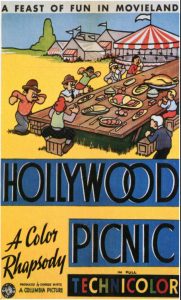 Hollywood Picnic (Mintz/Columbia, Color Rhapsody, 12/18/37 – Art Davis, dir.) – On the weekend, seemingly all the celebrities of Hollywood motor out to the country for a community picnic. Familiar faces abound, including among many Laurel and Hardy on a see-saw, W.C. Fields as a larcenous hot dog vendor (all dogs tethered to his apron, to be pulled out of the buns as soon as a customer turns away from the stand), Charles Laughton, George Arliss, Mae West, Clark Gable, and Jimmy Durante on a merry-go-round, Shirley Temple on a swing, etc. A baseball game gets underway, with Joe E. Brown as star putcher, pitching to the three Marx Brothers, who stand at the plate all at the same time. The first pitch sails by. Three batters likewise require three catchers – so the Three Stooges take the force of the ball, stopping its flight only after getting sprawled in the dirt, piled one atop another, from the pitch. Germanic comedian Herman Bing serves as umpire, calling “Strike One”, and gets hit with every popcorn sack and pop bottle in the place by unappreciative fans, followed by a pie in the face. On the second pitch, the Marxes connect with the ball, then hop all together upon a motorcycle, and take several laps around the bases, seemingly failing to tag any of them in the process. They ultimately crash the motorcycle into a tree, destroying it. The whole thing is for nothing, as umpire Bing calls, “Foul ball!” Another barrage of bags and bottles hits him, and another pie. For reasons unknown, the Marxes do not return to the plate to bat again. Instead, batting chores are passed to Stepin Fetchit, who, while he manages to connect with a pitch, trudges his way down the baseline so slowly, he’s likely to reach first in about two days. Again, his effort is for naught, as Bing again calls “Foul ball!” However, Bing is ready for the hostile fans this time, wearing a suit of armor. The bags and bottles bounce off the steel suit, and Bing safely pops his head out of the suit’s midriff – just in time to still take the pie in the face.
Hollywood Picnic (Mintz/Columbia, Color Rhapsody, 12/18/37 – Art Davis, dir.) – On the weekend, seemingly all the celebrities of Hollywood motor out to the country for a community picnic. Familiar faces abound, including among many Laurel and Hardy on a see-saw, W.C. Fields as a larcenous hot dog vendor (all dogs tethered to his apron, to be pulled out of the buns as soon as a customer turns away from the stand), Charles Laughton, George Arliss, Mae West, Clark Gable, and Jimmy Durante on a merry-go-round, Shirley Temple on a swing, etc. A baseball game gets underway, with Joe E. Brown as star putcher, pitching to the three Marx Brothers, who stand at the plate all at the same time. The first pitch sails by. Three batters likewise require three catchers – so the Three Stooges take the force of the ball, stopping its flight only after getting sprawled in the dirt, piled one atop another, from the pitch. Germanic comedian Herman Bing serves as umpire, calling “Strike One”, and gets hit with every popcorn sack and pop bottle in the place by unappreciative fans, followed by a pie in the face. On the second pitch, the Marxes connect with the ball, then hop all together upon a motorcycle, and take several laps around the bases, seemingly failing to tag any of them in the process. They ultimately crash the motorcycle into a tree, destroying it. The whole thing is for nothing, as umpire Bing calls, “Foul ball!” Another barrage of bags and bottles hits him, and another pie. For reasons unknown, the Marxes do not return to the plate to bat again. Instead, batting chores are passed to Stepin Fetchit, who, while he manages to connect with a pitch, trudges his way down the baseline so slowly, he’s likely to reach first in about two days. Again, his effort is for naught, as Bing again calls “Foul ball!” However, Bing is ready for the hostile fans this time, wearing a suit of armor. The bags and bottles bounce off the steel suit, and Bing safely pops his head out of the suit’s midriff – just in time to still take the pie in the face.
“Come and get it”, comes the call from the picnic table. While seemingly everyone stampedes to take their place at the table, Stepin Fetchit is still on the base line, having not heard the first call. A final call for chow reaches his ears, and he suddenly sets a land speed record to grab a seat on the table bench and devour watermelon. A funny sequence involves serving a side dish of peas to the attendees, but only supplying them with a knife to use as a utensil. John Barrymore is totally flustered as the peas continually roll off his knife, but Hugh Herbert has the problem licked, by dipping his knife in jelly before taking each swipe at the peas in his bowl. Edna Mae Oliver also creatively spears her peas with a hatpin, then eats then shish-kabob style. George Raft simply flips peas off his thumb one at a time onto his tonhue, much in the manner he would be known for repeatedly flipping coins with his hand in the movies. Martha Raye closes out the film with a rendition of “Truckin’: that gets everyone dancing – even Boris Karloff as Frankenstein’s monster. Night falls, and all the stars’ cars dance their way back to Holluwood, for the iris out.
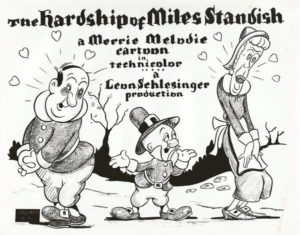 The Hardship of Miles Standish (Warner, Merrie Melodies, 4/27/40 – I. (Friz) Freleng, dir,) – A young boy and his old geezer of a Grandfather are listening to a radio adaptation of “The Courtship of Miles Standish”, with the broadcast just concluding. Grandpa turns off the radio in disgust, claiming, “Fiddlesticks! It didn’t happen that way at t’all. Even if it happened that way, it couldn’ta happened THAT way.” He proceeds to tell his grandson the way HE heard it (referencing a catch phrase of Bill Thompson’s character, “the Old Timer” from Fibber McGee and Molly). The twisted tale features Hugh Herbert as tongue-tied Miles Standish, Edna Mae Oliver as Priscilla, and Elmer Fudd as proprietor of the John Alden messenger service, delivering Miles’s mash note as a singing telegram, as he performs “You Must Have Been a Beautiful Baby.” An Indian attack disrupts the romantic moment, sending Elmer and Priscilla fleeing into her cabin and attempting to hold the fort against ambush. The Indians gather around the cabin from all tribes and compass points. Though Gramps only introduces one tribe as coming from the East, the grandson somehow gets a pretty clear mind’s-eye image of how they appear – riding horseback and with rifles, but dressed in baseball uniforms. “But Grandpa”, he protests, “they weren’t Indians. They were ball players.” “They were TOO Indians”, retorts Grandpa – “the Cleveland Indians!” The attack mounts, until one Indian accidentally fires an arrow shot through the plate glass of Priscilla’s front window. Elmer charges out, demanding to know who fired the shot, and stating, “One of you has got to pay for that gwass.” Like backlot baseball kids having busted a window with a baseball, the Indians scatter back to their reservations to avoid taking the blame. Priscilla declares Elmer to be her hero, and utters the famous words when Alden Fudd tells her that Standish loves her – “Speak for yourself, John.” The grandson doubts the story’s accuracy, and Grandpa backs up his tale with the boast that if it wasn’t the absolute truth, “I hope lightning strikes me.” A terrific bolt slashes through the roof of the home, destroying Grandpa’s easy chair, and leaving him hanging by his hands from one of the attic rafters. He repeats again the Old Timer’s line, “Anyhow, that’s the way I heard it!”
The Hardship of Miles Standish (Warner, Merrie Melodies, 4/27/40 – I. (Friz) Freleng, dir,) – A young boy and his old geezer of a Grandfather are listening to a radio adaptation of “The Courtship of Miles Standish”, with the broadcast just concluding. Grandpa turns off the radio in disgust, claiming, “Fiddlesticks! It didn’t happen that way at t’all. Even if it happened that way, it couldn’ta happened THAT way.” He proceeds to tell his grandson the way HE heard it (referencing a catch phrase of Bill Thompson’s character, “the Old Timer” from Fibber McGee and Molly). The twisted tale features Hugh Herbert as tongue-tied Miles Standish, Edna Mae Oliver as Priscilla, and Elmer Fudd as proprietor of the John Alden messenger service, delivering Miles’s mash note as a singing telegram, as he performs “You Must Have Been a Beautiful Baby.” An Indian attack disrupts the romantic moment, sending Elmer and Priscilla fleeing into her cabin and attempting to hold the fort against ambush. The Indians gather around the cabin from all tribes and compass points. Though Gramps only introduces one tribe as coming from the East, the grandson somehow gets a pretty clear mind’s-eye image of how they appear – riding horseback and with rifles, but dressed in baseball uniforms. “But Grandpa”, he protests, “they weren’t Indians. They were ball players.” “They were TOO Indians”, retorts Grandpa – “the Cleveland Indians!” The attack mounts, until one Indian accidentally fires an arrow shot through the plate glass of Priscilla’s front window. Elmer charges out, demanding to know who fired the shot, and stating, “One of you has got to pay for that gwass.” Like backlot baseball kids having busted a window with a baseball, the Indians scatter back to their reservations to avoid taking the blame. Priscilla declares Elmer to be her hero, and utters the famous words when Alden Fudd tells her that Standish loves her – “Speak for yourself, John.” The grandson doubts the story’s accuracy, and Grandpa backs up his tale with the boast that if it wasn’t the absolute truth, “I hope lightning strikes me.” A terrific bolt slashes through the roof of the home, destroying Grandpa’s easy chair, and leaving him hanging by his hands from one of the attic rafters. He repeats again the Old Timer’s line, “Anyhow, that’s the way I heard it!”
• THE HARDSHIP OF MILES STANDISH can be seen in its entirety on DailyMotion.
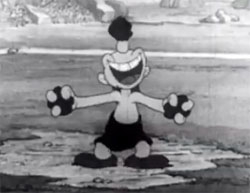 The Foul Ball Player (Fleischer/Paramount, Stone Age Cartoon, 5/24/40 – Dave Fleischer, dir./Bill Nolan/Ralph Sommerville, anim.) – Way back when baseball was just a diamond in the rough, we encounter a prehistoric game between the Granite Giants and the Marble Midgets. A tough-bearded bruiser of a pitcher named Butch meets the puny pitcher of the midgets (Joe), and shakes hands with his worthy opponent – locking the little-guy’s pitching hand in a painful vice grip. He also gets flirtatious with Joe’s girl, whom he almost drags away by the hair. Butch takes up his bat, taunting the midgets’ pitcher to put it over, “and I’ll knock it down your throat.” Using a rock for a ball, the first pitch is thrown. On the swing, the image of Butch morphs into a full locomotive and several freight cars, mowing Joe down. An announcer notes there was plenty of steam behind that one. Butch taunts the pitcher from first, but carelessly steps off the bag. Three players try to catch him between first and second, but he pulls the old gorilla-dachshund move of backtracking his feet to first base, while “stretching” his hit and his torso to second – then zips ahead for another steal at third. A second Giant socks one right at Joe, forcing him to retract his head into his neck to avoid being knocked off the mound. The rock sails straight into a rock-built concession stand selling hot dogs on the sidelines, and demolishes the booth. Out of the rubble, the hot dog chef rises, to hang a sign on the rock pile, reading “Business as usual during remodeling.” The two base runners skip along arm in arm toward home like a couple of school kids, as the pitcher watches helplessly. The third Giants batter hits one so hard, the rock shatters into three pieces. Joe makes three separate catches – two in his respective hands, and the third fragment neatly balanced on his head – and gets credit for an unassisted triple play.
The Foul Ball Player (Fleischer/Paramount, Stone Age Cartoon, 5/24/40 – Dave Fleischer, dir./Bill Nolan/Ralph Sommerville, anim.) – Way back when baseball was just a diamond in the rough, we encounter a prehistoric game between the Granite Giants and the Marble Midgets. A tough-bearded bruiser of a pitcher named Butch meets the puny pitcher of the midgets (Joe), and shakes hands with his worthy opponent – locking the little-guy’s pitching hand in a painful vice grip. He also gets flirtatious with Joe’s girl, whom he almost drags away by the hair. Butch takes up his bat, taunting the midgets’ pitcher to put it over, “and I’ll knock it down your throat.” Using a rock for a ball, the first pitch is thrown. On the swing, the image of Butch morphs into a full locomotive and several freight cars, mowing Joe down. An announcer notes there was plenty of steam behind that one. Butch taunts the pitcher from first, but carelessly steps off the bag. Three players try to catch him between first and second, but he pulls the old gorilla-dachshund move of backtracking his feet to first base, while “stretching” his hit and his torso to second – then zips ahead for another steal at third. A second Giant socks one right at Joe, forcing him to retract his head into his neck to avoid being knocked off the mound. The rock sails straight into a rock-built concession stand selling hot dogs on the sidelines, and demolishes the booth. Out of the rubble, the hot dog chef rises, to hang a sign on the rock pile, reading “Business as usual during remodeling.” The two base runners skip along arm in arm toward home like a couple of school kids, as the pitcher watches helplessly. The third Giants batter hits one so hard, the rock shatters into three pieces. Joe makes three separate catches – two in his respective hands, and the third fragment neatly balanced on his head – and gets credit for an unassisted triple play.
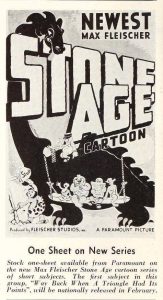 The midgets get their turn at bat. Their first “batter” is actually three batters – three of their players standing on each other’s shoulders, wielding three bats – a “triple threat”. Butch makes short work of them, pitching a spiral wind-up that circles each of the batters at his own level, drawing three strikes on one pitch for the out. “Who’s the next victim?”, taunts Butch. The second batter hits an easy line drive for an out at first – an out that really counts as an out, as the baseman slugs the runner into dizziness while making the tag. Joe steps up. Butch’s first pitch finds Joe repeating Popeye’s old gag – transforming into a swinging rusty gate. The writers embellish upon the old gag, by having Butch change his vocal read to an impression of Jerry Colonna, calling to Joe – “Greetings, Gate! You swung too late!” Butch pulls an old one from the Van Beuren library again, with his “Gum-drop” ball – the old chewing gum comebacker we’ve seen before. Then, Butch takes a time out to try to get a kiss for luck from Joe’s girl in the stands. The girl grabs the nearest thing handy to fling at Butch – a bouquet of goldenrod being sniffed by a fan in the next seat. Butch rears back, and begins complaining about his hay fever – as he starts to sneeze. The girl catches on, and races to Joe at the plate, handing him a goldenrod stalk. “He can’t take it”, she states, cueing Joe in to Butch’s weakness. While Joe sprinkles the plate with pollen, blowing a cloud of it Butch’s way, the girl begins handing out goldenrod to all the midget players. Everyone begins scoring hits, several of which clobber the sneezing Butch in the face, while scoring run after run. The whole midget bench crosses the bags, and Joe comes up to bat again. Instead of pitching the normal stone, Butch decides to “give him a base”, picking up the large square of stone that serves as first base, and hurling it at Joe while sneezing. Joe connects with it, bashing it into Butch, and sending Butch sailing into a rotating stone scoreboard operated by crank by another caveman in the outfield. Butch gets completely wound-up in the stone rollers of the board, while Joe scores a winning run. Joe ends the game by wrapping the remaining stalks of goldenrod around another stone, and smacking it to Butch at the scoreboard, where Butch’s mighty sneeze demolishes the scoreboard mechanism. The announcer closes with the remark, “A prehistoric baseball game was nothing to sneeze at.”
The midgets get their turn at bat. Their first “batter” is actually three batters – three of their players standing on each other’s shoulders, wielding three bats – a “triple threat”. Butch makes short work of them, pitching a spiral wind-up that circles each of the batters at his own level, drawing three strikes on one pitch for the out. “Who’s the next victim?”, taunts Butch. The second batter hits an easy line drive for an out at first – an out that really counts as an out, as the baseman slugs the runner into dizziness while making the tag. Joe steps up. Butch’s first pitch finds Joe repeating Popeye’s old gag – transforming into a swinging rusty gate. The writers embellish upon the old gag, by having Butch change his vocal read to an impression of Jerry Colonna, calling to Joe – “Greetings, Gate! You swung too late!” Butch pulls an old one from the Van Beuren library again, with his “Gum-drop” ball – the old chewing gum comebacker we’ve seen before. Then, Butch takes a time out to try to get a kiss for luck from Joe’s girl in the stands. The girl grabs the nearest thing handy to fling at Butch – a bouquet of goldenrod being sniffed by a fan in the next seat. Butch rears back, and begins complaining about his hay fever – as he starts to sneeze. The girl catches on, and races to Joe at the plate, handing him a goldenrod stalk. “He can’t take it”, she states, cueing Joe in to Butch’s weakness. While Joe sprinkles the plate with pollen, blowing a cloud of it Butch’s way, the girl begins handing out goldenrod to all the midget players. Everyone begins scoring hits, several of which clobber the sneezing Butch in the face, while scoring run after run. The whole midget bench crosses the bags, and Joe comes up to bat again. Instead of pitching the normal stone, Butch decides to “give him a base”, picking up the large square of stone that serves as first base, and hurling it at Joe while sneezing. Joe connects with it, bashing it into Butch, and sending Butch sailing into a rotating stone scoreboard operated by crank by another caveman in the outfield. Butch gets completely wound-up in the stone rollers of the board, while Joe scores a winning run. Joe ends the game by wrapping the remaining stalks of goldenrod around another stone, and smacking it to Butch at the scoreboard, where Butch’s mighty sneeze demolishes the scoreboard mechanism. The announcer closes with the remark, “A prehistoric baseball game was nothing to sneeze at.”
NEXT: Into the 1940’s, after a one-week station identification.